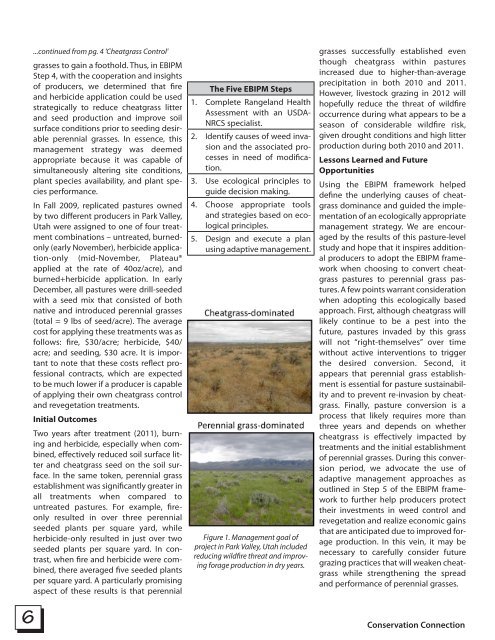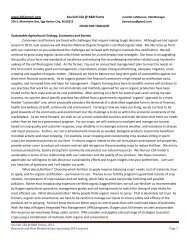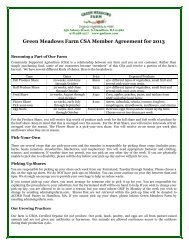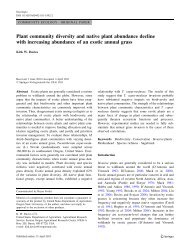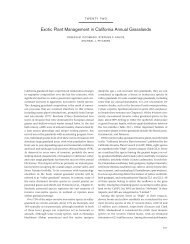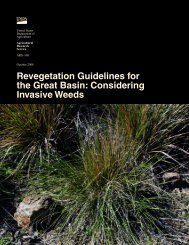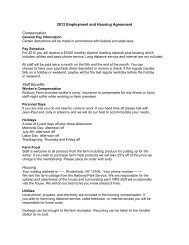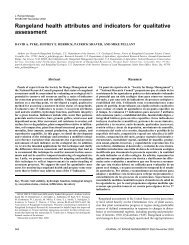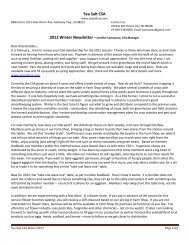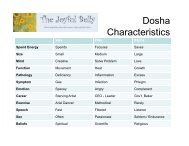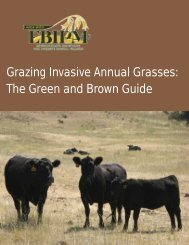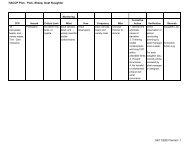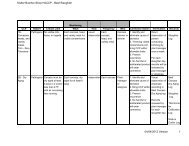Lessons learned from the EBIPM large- scale cheatgrass control and
Lessons learned from the EBIPM large- scale cheatgrass control and
Lessons learned from the EBIPM large- scale cheatgrass control and
- No tags were found...
Create successful ePaper yourself
Turn your PDF publications into a flip-book with our unique Google optimized e-Paper software.
...continued <strong>from</strong> pg. 4 'Cheatgrass Control'grasses to gain a foothold. Thus, in <strong>EBIPM</strong>Step 4, with <strong>the</strong> cooperation <strong>and</strong> insightsof producers, we determined that fire<strong>and</strong> herbicide application could be usedstrategically to reduce <strong>cheatgrass</strong> litter<strong>and</strong> seed production <strong>and</strong> improve soilsurface conditions prior to seeding desirableperennial grasses. In essence, thismanagement strategy was deemedappropriate because it was capable ofsimultaneously altering site conditions,plant species availability, <strong>and</strong> plant speciesperformance.In Fall 2009, replicated pastures ownedby two different producers in Park Valley,Utah were assigned to one of four treatmentcombinations – untreated, burnedonly(early November), herbicide application-only(mid-November, Plateau®applied at <strong>the</strong> rate of 40oz/acre), <strong>and</strong>burned+herbicide application. In earlyDecember, all pastures were drill-seededwith a seed mix that consisted of bothnative <strong>and</strong> introduced perennial grasses(total = 9 lbs of seed/acre). The averagecost for applying <strong>the</strong>se treatments was asfollows: fire, $30/acre; herbicide, $40/acre; <strong>and</strong> seeding, $30 acre. It is importantto note that <strong>the</strong>se costs reflect professionalcontracts, which are expectedto be much lower if a producer is capableof applying <strong>the</strong>ir own <strong>cheatgrass</strong> <strong>control</strong><strong>and</strong> revegetation treatments.Initial OutcomesTwo years after treatment (2011), burning<strong>and</strong> herbicide, especially when combined,effectively reduced soil surface litter<strong>and</strong> <strong>cheatgrass</strong> seed on <strong>the</strong> soil surface.In <strong>the</strong> same token, perennial grassestablishment was significantly greater inall treatments when compared tountreated pastures. For example, fireonlyresulted in over three perennialseeded plants per square yard, whileherbicide-only resulted in just over twoseeded plants per square yard. In contrast,when fire <strong>and</strong> herbicide were combined,<strong>the</strong>re averaged five seeded plantsper square yard. A particularly promisingaspect of <strong>the</strong>se results is that perennialThe Five <strong>EBIPM</strong> Steps1. Complete Rangel<strong>and</strong> HealthAssessment with an USDA-NRCS specialist.2. Identify causes of weed invasion<strong>and</strong> <strong>the</strong> associated processesin need of modification.3. Use ecological principles toguide decision making.4. Choose appropriate tools<strong>and</strong> strategies based on ecologicalprinciples.5. Design <strong>and</strong> execute a planusing adaptive management.Figure 1. Management goal ofproject in Park Valley, Utah includedreducing wildfire threat <strong>and</strong> improvingforage production in dry years.grasses successfully established eventhough <strong>cheatgrass</strong> within pasturesincreased due to higher-than-averageprecipitation in both 2010 <strong>and</strong> 2011.However, livestock grazing in 2012 willhopefully reduce <strong>the</strong> threat of wildfireoccurrence during what appears to be aseason of considerable wildfire risk,given drought conditions <strong>and</strong> high litterproduction during both 2010 <strong>and</strong> 2011.<strong>Lessons</strong> Learned <strong>and</strong> FutureOpportunitiesUsing <strong>the</strong> <strong>EBIPM</strong> framework helpeddefine <strong>the</strong> underlying causes of <strong>cheatgrass</strong>dominance <strong>and</strong> guided <strong>the</strong> implementationof an ecologically appropriatemanagement strategy. We are encouragedby <strong>the</strong> results of this pasture-levelstudy <strong>and</strong> hope that it inspires additionalproducers to adopt <strong>the</strong> <strong>EBIPM</strong> frameworkwhen choosing to convert <strong>cheatgrass</strong>pastures to perennial grass pastures.A few points warrant considerationwhen adopting this ecologically basedapproach. First, although <strong>cheatgrass</strong> willlikely continue to be a pest into <strong>the</strong>future, pastures invaded by this grasswill not “right-<strong>the</strong>mselves” over timewithout active interventions to trigger<strong>the</strong> desired conversion. Second, itappears that perennial grass establishmentis essential for pasture sustainability<strong>and</strong> to prevent re-invasion by <strong>cheatgrass</strong>.Finally, pasture conversion is aprocess that likely requires more thanthree years <strong>and</strong> depends on whe<strong>the</strong>r<strong>cheatgrass</strong> is effectively impacted bytreatments <strong>and</strong> <strong>the</strong> initial establishmentof perennial grasses. During this conversionperiod, we advocate <strong>the</strong> use ofadaptive management approaches asoutlined in Step 5 of <strong>the</strong> <strong>EBIPM</strong> frameworkto fur<strong>the</strong>r help producers protect<strong>the</strong>ir investments in weed <strong>control</strong> <strong>and</strong>revegetation <strong>and</strong> realize economic gainsthat are anticipated due to improved forageproduction. In this vein, it may benecessary to carefully consider futuregrazing practices that will weaken <strong>cheatgrass</strong>while streng<strong>the</strong>ning <strong>the</strong> spread<strong>and</strong> performance of perennial grasses.6Conservation Connection


